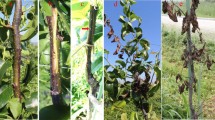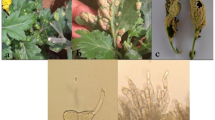Abstract
Cashewnut leaf spot is an important foliar disease in cashewnut seedling in West Bengal, India. The present study was aimed to identify and characterize the causal organism associated with cashewnut leaf spot and also to find out its best management strategies. Two cashewnut nurseries at Jhargram and Mohanpur were surveyed and four isolates of the pathogen were isolated from infected leaf tissue. The pathogen was identified as Pestalotiopsis oxyanthi (Thumen) Steyaert based on morphological features and ITS sequence data. Phylogenetic analysis using sequence data placed the four isolates in a single clade. Disease progress rate was positively correlated with the weather parameters like maximum relative humidity (RH), mean RH and rainfall data in both years. Pyraclostrobin inhibited mycelial growth of the pathogen most followed by thiophanate methyl and carbendazim + mancozeb against pathogen with ED50 values of 0.362, 0.839 and 1.137 ppm, respectively. All the tested fungicides revealed significant effect on disease severity of leaf spot and reduced disease severity after four sprayings. It has been observed from two years pooled data that pyraclostrobin treated seedling showed lowest disease severity (DS), area under disease progress curve (AUDPC) and highest percent disease reduction over untreated control of 23.00%, 1200.00 and 61.02%, respectively.





Similar content being viewed by others
References
Anonymous (2018) Horticultural statistics at a glance 2018. Ministry of Agriculture & Farmers’ Wellfare, Govt. of India, p458
Barr ME (1990) Prodromus to nonlichenized, pyrenomycetous members of class hymenoascomycetes. Mycotaxon 39:43–184
Brown W (1924) A method of isolating single strains of fungi by cutting out a hyphal tip. Annals Bot 38(150):402–404
Cardoso JE, Martins MVV, Freire FCO, Viana FMP, Lima JS, Silva LGC, Melo JGM (2014) An epidemic outbreak of cashew powdery mildew in Brazil. Proceedings of annual meeting archives, minneapolis. anais, aps-cps joint meeting, American Phytopathological Society, 9–13 August, p 178
Chen Y, Zeng L, Shu N, Jiang M, Wang H, Huang Y, Tong H (2018) Pestalotiopsis-like species causing gray blight disease on Camellia sinensis in China. Plant Dis 102(1):98–106
Chomnunti P, Schoch CL, Aguirre-Hudson B, Ko-Ko TW, Hongsanan S, Jones EBG, Kodsueb R, Phookamsak R, Chukeatirote E, Bahkali AH, Hyde KD (2011) Capnodiaceae. Fungal Diver 51:103–134. https://doi.org/10.1007/s13225-011-0145-6
Darlington CD, Janaki Ammal EK (1945) Chromosome atlas of cultivated plants. Allen and Unwin Ltd., London, p p397
Das R, Jha DK (2008) Evaluation of some chemicals against P. disseminata causing grey blight of som. Sericologia 48(1):113–117
Espinoza JG, Briceño EX, Keith LM, Latorre BA (2008) Canker and twig dieback of blueberry caused by Pestalotiopsis spp. and a Truncatella sp. in Chile. Plant Dis 92:1407–1414
Freire FCO, Cardoso JE, Dos Santos AA, Viana FMP (2002) Diseases of cashew nut plants (Anacardium occidentale L.) in Brazil. Crop Prot 21(6):489–494
Grover RK, Moore JD (1962) Toxicometric studies of fungicides against brown rot organism, Sclerotinia fruiticola and S. laxa. Phytopathology 52:876
Guba EF (1956) Monochaetia and Pestalotia vs Truncatella, Pestalotiopsis and Pestalotia. Annals Microb 7:74–76
Guba EF (1961) Monograph of Pestalotia and Monochaetia. Harvard University Press, Cambridge
Hopkins KE, McQuilken MP (2000) Characteristics of Pestalotiopsis associated with hardy ornamental plants in the UK. Eur J Plant Pathol 106:77–85
Hu HL, Jeewon R, Zhou DQ, Zhou TX, Hyde KD (2007) Phylogenetic diversity of endophytic Pestalotiopsis species in Pinus armandii and Ribes spp.: evidence from rDNA and β-tubulin gene phylogenies. Fungal Divers 24:1–22
Intini M, Sijaona MER (1983) Little known disease of cashew (Anacardium occidentale L.) in Tanzania. Riv Agr Subtrop Trop 77:421–429
Islam MN, Poddar KK, Hossain I, Chowdhury MSM, Uddin AJ, Mehraj H (2015) Relationship of mango seedling diseases prevalence to the environmental factors. Scientia 10(3):137–144
Ismail AM, Cirvilleri G, Polizzi G (2013) Characterisation and pathogenicity of Pestalotiopsis uvicola and Pestalotiopsis clavispora causing grey leaf spot of mango (Mangifera indica L.) in Italy. Eur J Plant Pathol 135:619–625
Jeewon R, Liew ECY, Simpson JA, Hodgkiss IJ, Hyde KD (2003) Phylogenetic significance of morphological characters in the taxonomy of Pestalotiopsis species. Mol Phylogenet Evol 27:372–383
Johnson D (1973) The botany, origin, and spread of the cashew Anacardium occidentale L. J Plant Crops1:1–7
Joshi MS (2005) Leaf blight of cashew incited by Pestalotia heterocornis Guba. Indian Phytopath 58(2):252
Keith LM, Velasquez ME, Zee FT (2006) Identification and characterization of Pestalotiopsis spp. causing scab disease of guava Psidium guajava in Hawaii. Plant Dis 90:16–23
Khatun A, Mohapatra A, Satapathy KB (2017) Major diseases of cashew (Anacardium occidentale L.) caused by fungi and their control in Odisha, India. Int J Biosci 11(1):68–74
Lee S, Crous PW, Wingfield MJ (2006) Pestalotioid fungi from Restionaceae in the Cape Floral Kingdom. Stud Mycol 55:175–187
Liu AR, XP W, Xu T, Guo LD, Wei JG (2006) Notes on endophytic Pestalotiopsis from Hainan, China. Mycosystema 25:389–397
Liu L, Liu S, Jiang L, Chen X, Guo L, Che Y (2008) Chloropupukeananin, the first chlorinated pupukeanane derivative, and its precursors from Pestalotiopsis fici. Org Lett 10:1397–1400
Liu AR, Chen SC, Wu SY, Xu T, Guo LD, Jeewon R, Wei JG (2010) Cultural studies coupled with DNA based sequence analyses and its implication on pigmentation as a phylogenetic marker in Pestalotiopsis taxonomy. Mol Phylogenet Evol 57:528–535
López AMQ, Lucas JA (2010) Colletotrichum isolates related to anthracnose of cashew trees in Brazil: morphological and molecular description using LSU rDNA sequences. Braz Arch Biol Technol 53(4):741–752
Maharachchikumbura SSN, Guo LD, Chukeatirote E, Bahkali AH, Hyde KD (2011) Pestalotiopsis morphology, phylogeny, biochemistry and diversity. Fungal Divers 50(1):167–187
Maharachchikumbura SSN, Chukeatirote E, Guo LD, Crous PW, Mckenzie EHC, Hyde KD (2013a) Pestalotiopsis species associated with Camellia sinensis (tea). Mycotaxon 123:47–61
Maharachchikumbura SSN, Guo LD, Chukeatirote E, McKenzie EH, Hyde KD (2013b) A destructive new disease of Syzygium samarangense in Thailand caused by the new species Pestalotiopsiss amarangensis. Trop Plant Pathol 38(3):227–235
Maharachchikumbura SSN, Hyde KD, Groenewald JZ, Xu J, Crous PW (2014) Pestalotiopsis revisited. Stud Mycol 79:121–186
McQuilken MP, Hopkins KE (2004) Biology and integrated control of Pestalotiopsis on container grown ericaceous crops. Pest Manag Sci 60(2):135–142
Monteiro F, Romeiras MM, Figueiredo A, Sebastiana M, Balde A, Catarino L, Batista D (2015) Tracking economically important disease in west african region using metagenomics. Front Plant Sci 6:482
Pirone PP (1978) Diseases and pests of ornamental plants. John Wiley & Sons, New York
Ray MK, Mishra PK, Baruah PK (2016) Control of fungal pathogen Pestalotiopsis disseminata causing grey blight disease in som (Persea bombycina Kost.): an in vitro study. Indian J Pure Appl Biosci 4(6):180–185
Ren HY, Li G, Qi XJ, Fang L, Wang H, Wei J, Zhong S (2013) Identification and characterization of Pestalotiopsis spp. causing twig blight disease of bayberry (Myrica rubra Sieb. & Zucc) in China. Eur J Plant Pathol 137:451–461
Rivera MC, Wright ER (2000) First report of azalea petal blight caused by Pestalotiopsis guepini in Argentina. Plant Dis 84:100
Saju KA, Mech S, Deka TN, Biswas AK (2011) In vitro evaluation of biocontrol agents, botanicals and fungicides against Pestalotiopsis sp. infecting large cardamom (Amomum subulatum Roxb.).JOSAC. 20(2): 89–92
Saroj PL, Rupa TR (2014) Cashew research in India: achievements and strategies. Progressive Hort 46:1–17
Sijaona MER, Clewer A, Maddison A, Mansfield JW (2001) Comparative analysis of powdery mildew development on leaves, seedlings and flower panicles of different genotypes of cashew. Plant Pathol 50(2):234–243
Steyaert RL (1949) Contributions al’etudemonographique de Pestalotia de not. Et Monochaetia Sacc. (Truncatella gen. nov. et Pestalotiopsis gen. nov). Bull Jardin Botanique Etat Bruxelles 19:285–354
Uaciquetea A, Korstenb L, Waalsb JEVD (2013a) A search for anthracnose resistant cashew cultivars in Mozambique. Crop Prot 50:6–11
Uaciquetea A, Korstenb L, Waalsb JEVD (2013b) Epidemiology of cashew anthracnose (Colletotrichum gloeosporioides Penz). Crop Prot 49:66–72
Website DCR Directorate of cashew research, Puttur, Karnataka, India. https://cashew.icar.gov.in/cashew-statistics-2/, access on 01.12.2021
Wei JG, Xu T, Guo LD, Liu AR, Zhang Y, Pan XH (2007) Endophytic pestalotiopsis species associated with plants of Podocarpaceae, Theaceae and Taxaceae in southern China. Fungal Divers 24:55–74
White TJ, Bruns TD, Lee SB, Taylor JW (1990) Amplification and sequencing of fungal ribosomal RNA genes for phylogenetics. In: Gelfand DN, Sninsky J, White TC (eds) PCR protocols and applications-a guide to methods and applications. Academic, San Diego., pp 315–322
Wilcoxson RD, Srovmand B, Atif AH (1975) Evaluation of wheat cultivars for ability to retard development of stem rust. Ann Appl Biol 80:275–281
Wonni I, Sereme D, Ouedraogo I, Kassankagno AI, Dao I (2017) Diseases of cashew nut plants (Anacardium occidentale L.) in Burkina Faso. Adv Plants Agric Res 6(3):00216. https://doi.org/10.15406/apar.2017.06.00216
Xavier KV, Kc AN, Vallad GE (2020) Fungicide application timing essential for the management of leaf spot and fruit rot on pomegranate (Punica granatum L.) in Florida. Plant dis 104(6):1629–1637
Yanna HW, Hyde KD (2002) Fungal succession on fronds of Phoenix hanceana in Hong Kong. Fungal Divers 10:185–211
Zhang YM, Maharachchikumbura SSN, McKenzie EHC, Hyde KD (2012a) A novel species of Pestalotiopsis causing leaf spots of Trachycarpus fortune. Cryptogam Mycol 33:1–8
Zhang YM, Maharachchikumbura SSN, Wei JG, McKenzie EHC, Hyde KD (2012b) Pestalotiopsis camelliae, a new species associated with grey blight of Camellia japonica in China. Sydowia 64:335–344
Zhang YM, Maharachchikumbura SSN, Tian Q, ,Hyde KD (2013) Pestalotiopsis species on ornamental plants in Yunnan Province, China. Sydowia 65:59–74
Acknowledgements
The authors thankfully acknowledge the Director of Research, Bidhan Chandra Krishi Viswavidyalaya for providing necessary support for conducting the experiment.
Author information
Authors and Affiliations
Corresponding author
Ethics declarations
Conflict of interest
The authors declare that they don’t have any conflict of interest.
Ethical approval
This article does not contain any studies with humanparticipants or animals performed by any of the authors.
Additional information
Publisher’s Note
Springer Nature remains neutral with regard to jurisdictional claims in published maps and institutional affiliations.
Rights and permissions
Springer Nature or its licensor (e.g. a society or other partner) holds exclusive rights to this article under a publishing agreement with the author(s) or other rightsholder(s); author self-archiving of the accepted manuscript version of this article is solely governed by the terms of such publishing agreement and applicable law.
About this article
Cite this article
Patsa, R., Jash, S., Dutta, S. et al. Pestalotiopsis leaf spot: an important foliar disease in cashewnut seedling incited by Pestalotiopsis oxyanthi in West Bengal, India. Indian Phytopathology 76, 713–725 (2023). https://doi.org/10.1007/s42360-023-00641-w
Received:
Revised:
Accepted:
Published:
Issue Date:
DOI: https://doi.org/10.1007/s42360-023-00641-w




